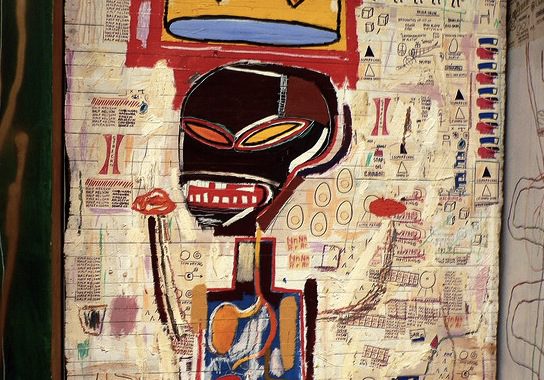New Basquiat Murals: Warhol’s Touch Still Golden

Artinfo reported Wednesday that an old girlfriend of 1980s graffiti artist Jean-Michel Basquiat is preparing to unveil a trove of personal ephemera from their days living together in the East Village. The apartment, which Alexis Adler owns, is still decorated with Basquiat’s skeletal scrawls: a mural that reads “Olive Oyl,” a painting of crowns and the words “Famous Negro Athletes” on a door, and the word “Milk” on a radiator. Seeing that a mini-retrospective of Basquiat’s works at the Gagosian gallery is attracting over 4000 visitors a day, that his’s paintings regularly sell at auction for over $10 million, and that in 2012, for the second year running, sales of his paintings, clocking in at €80m, far outstripped the take of any other artist born after 1945, this is no empty news for New York City, and great business for Adler.
Basquiat’s heads are stitched together like Frankenstein’s monster, psychotic rage and despair leaking out of the skull. His later work became rude, childish, and weak. Perhaps fame undercut his sense of righteous fury. But aside from any consideration of the merits of his work, it goes to show that Andy Warhol’s sympathetic touch still reaches out from the grave and turns to gold all the labors of his reverent Maenads.
Basquiat didn’t find a critical audience until 1979, where he started making appearances on Glenn O’Brien’s (now the GQ style guy) cable show TV Times. Glenn was a early member of Warhol’s Factory, and editor-in-chief of his literary outlet Interview. Basquiat introduced himself to Warhol in 1980, and the two collaborated heavily after that. In Victor Bockris’s Warhol: A Biography, long-time Warhol assistant Ronny Cutrone describes the relationship:
It was like some crazy art-world marriage and they were the odd couple. The relationship was symbiotic. Jean-Michel thought he needed Andy’s fame, and Andy thought he needed Jean-Michel’s new blood. Jean-Michel gave Andy a rebellious image again.
But it wasn’t until in 1981 when an article, entitled “The Radiant Child,” appeared in ArtForum praising Basquiat that he came to the attention of a wider art audience. The author of the article was René Ricard, also an Andy Warhol protégé.
After Warhol’s death in 1987, Basquiat became isolated and depressed, and eventually died overdosing on heroin. Basquiat’s unhinged violence curiously balances Warhol’s soporifics. Warhol was a sort of anti-Tao, a placid centre unleashing chaos around him.
———
I leave you with a gratuitous illustration of Warhol’s seeming ubiquity: Andy Warhol met one of his “superstars,” the transvestite Candy Darling (who also committed suicide at a young age), in 1967 at a gangster-owned club called the Tenth of Always in NYC, while sitting with Velvet Underground lead Lou Reed. Candy was performing in “Glamour, Glory and Gold,” a play written by drag queen Jackie Curtis, another Warhol star. On stage alongside Candy and Jackie was one man, in his first-ever acting job, playing all six male parts. His name was Robert de Niro.
Comments